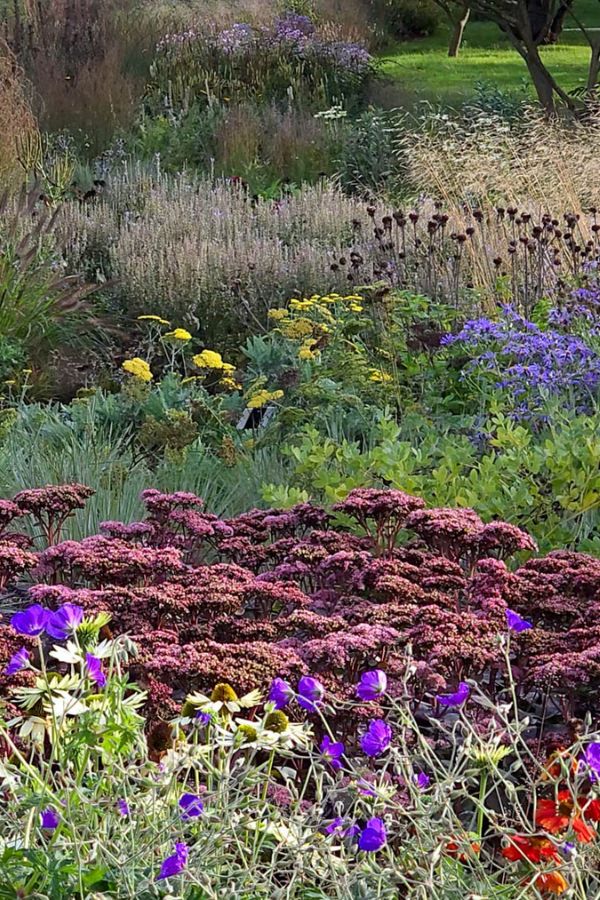5 classes in planting model from the brand new Oudolf borders at RHS Wisley – The Center-Sized Backyard
The brand new Piet Oudolf borders at RHS Wisley are an actual lesson in planting design.
And whether or not you’ve gotten a big area or only a small yard, there are concepts and plant combos for residence gardeners in addition to professionals.
(Strictly talking, the world is named the ‘Oudolf Panorama’ or ‘The Glasshouse Borders’ )
The Oudolf Panorama is a hill stretching gently up from the magnificent glasshouses. As you method, a discover will let you know that the planting is in Oudolf’s ‘signature mixture of block and matrix planting.’

Go to RHS Wisley in Surrey to immerse your self within the re-vamped Piet Oudolf borders.
That is also known as ‘naturalistic planting’.
It’s actually a fast approach of making a superb border. I visited the Oudolf Panorama on the RHS backyard at Wisley simply six months after it was planted up from naked soil. And though there have been gaps the place the decorative grasses have but to mature, the borders regarded gorgeous even of their first yr. They are going to go on getting higher as they fill out.
They changed twenty-year outdated ‘naturalistic’ Oudolf borders. The RHS describes the world as essentially the most important Oudolf borders within the UK.
I warmly suggest that you simply take a stroll across the Oudolf Panorama at RHS Wisley. In case you can’t get there in individual, then don’t miss the video right here.
Lesson 1: What’s Piet Oudolf’s naturalistic planting model?
Firstly, what’s naturalistic planting?
It’s described as an ‘artistically stylised model of pure habitats’. Noel Kingsbury and Piet Oudolf outline it of their basic ebook on naturalistic planting in ‘Planting – A New Perspective’. (Please word: hyperlinks to Amazon are affililate, see disclosure)
It means you mix crops that develop properly naturally in your space. And then you definately plant them in patterns that mirror -somewhat – how they’d develop in nature.
Select crops that want comparable situations and are acceptable to the soil and local weather. So that they received’t want the sort of intensive gardening care – the person pruning and fertilising of sure crops – that some conventional herbaceous borders want.
Naturalistic or pure?
Many eager gardeners say that seeing crops within the wild helps them perceive how they behave within the backyard.
In case you’re pondering of doing naturalistic planting in your personal backyard, go to gardens that showcase the model. This consists of RHS Wisley, Hauser & Wirth in Somerset and lots of public landscapes, such because the Excessive Line in New York.
And likewise have a look at how crops develop in pure landscapes close to you.
Typically when a good friend and I stroll across the native marshes with their drifts of untamed grasses, we are saying ‘it’s all trying very Piet Oudolf right now.’
And my sister-in-law in Vermont has allowed her subject to be taken over utterly by wild New England asters (Symphyotrichum novae-angliae), Showy Goldenrod (Solidago speciosa) and Joe Pye Weed (Eutrochium purpurea). It appears to be like very ‘Oudolf’!
Seeing this meadow was a revelation. In some locations you would virtually think about it had been planted up.


Piet Oudolf borders with asters and hylotelephium at RHS Wisley (prime) and a subject of untamed asters and eutrochium in Vermont (above). The Vermont subject is totally wild – completely created by nature, whereas the Oudolf borders above it are intentionally designed and planted with a mixture of ‘block planting and matrix planting’.
Naturalistic planting isn’t the identical as re-wilding (see Uncover the Magic of A Re-Wilded Backyard).
And, though naturalistic planting, such because the Piet Oudolf Panorama at RHS Wisley, may be very sustainable and wildlife-friendly, you might be sustainable and wildlife-friendly with out essentially proscribing your self to naturalistic planting.
However it’s an efficient and dramatic model of planting.
Lesson 2: What’s the distinction between block planting and matrix planting?
To grasp the ideas behind naturalistic planting, take into consideration block planting and matrix planting.
Piet Oudolf defines ‘block planting’ as a conventional planting idea. It’s a large block of 1 sort of plant. He considers that there are benefits and downsides to dam planting.
The principle benefits are that it’s straightforward to plant and preserve, which is why you typically see large blocks of an identical flowers in parks. Any weed will immediately be noticeable, which implies that even non-experts can weed it out.
And another therapy, corresponding to chopping down or chopping again, might be finished clump by clump, somewhat than plant by plant.


Hylotelephium (previously Sedum) ‘Matrona’ in block planting within the Piet Oudolf borders at RHS Wisley. The block provides a giant punch of color, repeated elsewhere within the borders. And you may see the extra casual ‘matrix planting’ weaving collectively the opposite crops.
Ian Trought, an RHS horticulturalist on the Oudolf Panorama, says that in a big panorama, block planting creates the mandatory pops of color. When you have a giant area, you want large chunks of color.
Block planting doesn’t work as properly in smaller gardens although, he says. You’d have one large pop of color for just a few weeks, then not a lot to take pleasure in after that.
And Noel Kingsbury writes that block planting can be considerably old style (consider these geometric blocks of bedding crops in municipal parks!)
Lesson 3: Oudolf borders – matrix planting is sort of a fruit cake…
‘There are a whole lot of completely different solutions to the query ‘what’s matrix planting’,’ says Noel Kingsbury in ‘Planting – A New Perspective’. Nevertheless he and Piet Oudolf describes it as being ‘like a fruit cake’.
You plant an preliminary matrix of 1 plant repeated. That is typically a decorative grass, which is just like the ‘cake combine’ of a fruit cake. For instance, grasses corresponding to Carex, Deschampsia cepitosa or smaller Molinias are sometimes used as ‘matrix crops’. These set up a background, then you possibly can thread different crops via them.
Ian Trought additionally describes it as a planting of decorative grasses with perennials dotted in via them. The grasses will develop and unfold to create a everlasting background. It has been described as a ‘river of grasses.’
Then the colorful salvias, yarrow and asters are planted in teams amongst them. These create splashes of color – just like the fruit and nuts of a fruit cake, in response to Kingsbury.
It’s not the one use of decorative grasses on this border, nonetheless. Occasionally a single grass, corresponding to a Pennisetum or a Festuca, stands on the entrance of a border to interrupt up vibrant blocks of flowers.


Dense ‘matrix and block planting’ discourages weeds and has a natural-looking relaxed really feel. Because the borders develop and develop, completely different crops will dominate at completely different seasons.
Matrix planting additionally combines crops with comparable or complementary wants. For instance, shallow-rooted grasses and deeper rooted perennials can develop properly collectively even once they’re densely planted as a result of they’re not occupying precisely the identical layer of soil.
So naturalistic planting is less complicated to take care of, too. The best is to create a natural-looking border which is so filled with crops you need that it excludes weeds.
So plant the grasses first
In case you’re ranging from scratch with naturalistic borders, then plant the grasses first.
And even in case you’re not essentially doing naturalistic planting, then the ‘grasses first’ philosophy works properly. Paul Seaborne of Pelham Crops says that he all the time positions the person decorative grasses first in a border, then works the remainder of the planting round it.
In case you love cottage backyard model, then see how Tim Pilgrim provides grasses to the standard cottage backyard vary of crops to create a up to date cottage backyard.
Lesson 4: new concepts for a slope from the Oudolf borders
The brand new Oudolf borders have one main design change which basically alters the connection of the customer to the backyard.
The borders of twenty years in the past lined a large, straight path, going up the hill. You might view the borders on both the facet as you walked up the hill. And you would look down on them while you reached the highest.


Piet Oudolf borders at Wisley from 2001-2024. This earlier scheme had one central path going from the highest to the underside of the slope, with naturalistic borders on both facet. Images: Prime by Neil Hepworth. Above by Adam Alexander. Images reproduced by permission RHS.
Now there’s a broad curving path snaking up the hill, going from one facet to the opposite.
You’re immersed within the border from each side, with a special view each time you flip the nook. It’s additionally extra wheelchair/wheelbarrow-friendly, because the slope is much less steep when it zig-zags back and forth.


The curving zig-zag path is designed to sluggish you down and immerse you within the planting. There are benches on each degree, so you possibly can sit and benefit from the view all the way down to the glasshouses.
And while you see folks coming down the trail, it appears to be like as in the event that they’re strolling via the center of the planting. Oudolf describes this as a approach of slowing you down and permitting you benefit from the borders extra.
In case you’re pondering of steps or terracing for a sloping backyard, take into account whether or not any such zig-zag path could be be simpler to dwell with and provide extra views of the backyard.
Ian Trought says that you must take into account drainage on a slope. Not solely does that imply the way in which you plant on a slope, but in addition how water flowing downhill might have an effect on the paths. The earlier extensive grass path bought too muddy with folks tramping over it and rainwater taking place hill. The brand new lateral paths have drainage constructed into them.
The Oudolf borders additionally showcase the worth of a slope for exhibiting off border crops. As a result of the standard ‘large crops on the again, smaller ones on the entrance’ is just not a part of any such design, a slope offers you an excellent view of the entire border.
See right here for extra design and planting concepts for gardening on a slope.


Every slope degree has a pleasant bench. You’ll be able to pause to benefit from the planting stretching out under you.
Lesson 5: Repetition and distinction in Oudolf borders
These Oudolf borders are a lesson in repetition and distinction. The massive blocks of color are repeated throughout the panorama. All the person flower and grass species are repeated all the way in which up the hill. There are 155 species of plant in all, which isn’t very a lot when you think about the dimensions of the hill.
Then the distinction comes from the variations within the plant shapes, color and construction.


Right here you possibly can see each repetition and distinction. The daisy flowers of Aster ‘New Jersey Skies’ contrasts with the rounded clumps of Hylotelephium ‘Matrona’. The naturalistic planting contrasts with the sharp edging of the trail. And the spiky stems of Atlas Fescue grass distinction with thicker fleshy leaves of the hylotelephium.
There’s extra distinction between the way in which the crops are interweaved collectively, but the trail is sharply delineated with edging. Comfortable planting. Laborious edged path. Spiky plant. Rounded plant.
All of it works collectively to present your eye a lot to take a look at.
I don’t assume this model of planting would work in very small gardens. You’d want a middle-sized or bigger backyard to create this impact. However I do assume it’s price fascinated with what the construction or structure of a plant contributes to a border in any dimension backyard.
How can I create a small-scale model of Piet Oudolf’s model?
Ian says you could repeat the identical combos of crops on a smaller scale. Use the identical crops, however fewer of them.
Select a background grass, then add some perennials into the planting. This implies you received’t have gaps if some fail.
A few of the matrix crops within the Oudolf borders at RHS Wisley are fairly delicate grasses, corresponding to Prairie Dropseed (Sporobolus heterolepsis), Tufted Hair Grass (Deschampsia cespitosa) and Molinia ‘Poul Peterson.’
And Noel Kingsley & Piet Oudolf suggest that you simply assume extra concerning the construction and structure of the plant than you do about its flowers.
Construction gives you long run influence. You received’t need to rely solely on flower color to make your border stunning.


Distinction the structure or construction of the planting. Right here you possibly can see how the rounded mounds of aster and stable blocks of hylotelephium distinction with the skinny grassy spikes of Festuca.
And Ian additionally recommends ‘Planting – A New Perspective’ for plant alternative as a result of it has a chart on the again, itemizing the crops that Oudolf makes use of typically, with their top, season of curiosity, the form of their foliage, their structural curiosity and what number of you plant per metre. ‘It’s like a recipe for planting.’
You don’t have to purchase the most important crops
He additionally says that you simply don’t need to spend a lot of cash on crops. ‘We planted your complete Oudolf Panorama with crops in 9cm pots, so that you don’t have to purchase the dearer 2L pots. And in case you do, you possibly can typically cut up them into two or extra crops.’
The Oudolf borders at RHS Wisley are solely round 6 months outdated. The 9cm crops have already stuffed a lot of the area. ‘Though we’ve been fortunate that there’s been loads of rain this summer season,’ says Ian. There are only a few gaps, primarily the grasses matrix, however these gaps will likely be stuffed by the rising grasses by subsequent summer season.
The RHS Wisley Oudolf Panorama options hylotelephium (fomerly Sedum), echinacea, hardy geraniums, asters, heleniums, rudbeckia and stachys. These are all crops usually utilized in Oudolf borders. And so they all work equally properly in smaller gardens.


Achillea (yarrow) ‘Moonshine’ and Echinacea pallida ‘Hula Dancer’ with Aster ‘New Jersey Skies’ within the Piet Oudolf panorama at RHS Wisley. All these crops work properly in smaller gardens. You’ll be able to see the yarrow flower heads ‘going over’, however they’re left till late February to profit wildlife.
How do you preserve a Piet Oudolf impressed backyard?
You received’t need to do the standard border jobs of dead-heading, chopping again or changing crops which have gone over with annuals. And there’s little or no watering, too.
When crops go over on this naturalistic planting, their seedheads stay till they collapse. There are a whole lot of decorative grasses in matrix planting. Most preserve their construction all through winter. So as a substitute of clearing away, you possibly can benefit from the structural fantastic thing about crops which might be ‘over.’ ‘We depart the crops in these borders standing till late February,’ says Ian Trough.


These borders are ‘left standing’ till late February. By the point they’re cleared away, they’ll have began to disintegrate, however they’ve supplied shelter and seedheads to wildlife over winter.
Nevertheless, naturalistic planting is just not re-wilding and also you do have some management. Weed out self-seeders (until you need to maintain them.) And most grasses want chopping down annually within the spring.
Perennials, too, will want an annual clearing away, in response to their varied necessities. However, as Steve Edney and Lou Dowle level out in Sensible Border Upkeep, leaving crops over winter typically means there’s little or no to clear away in spring. The collapsing vegetation will have already got began to interrupt down.
Naturalistic planting additionally focusses on crops that received’t want an excessive amount of watering, too. Particular person pampering of crops is out! Have a look at find out how to make a dry backyard and 10 stunning however robust perennials for options of drought-resistant crops. And likewise see 15 drought tolerant crops that can even be joyful if it rains.
Whenever you select your crops, make an observation of their care necessities. Attempt to place crops that want comparable care – corresponding to chopping again – on the identical time of yr. In order that makes sustaining the borders a a lot simpler job.
How one can plant a border like professional gives you some extra good planting suggestions.
What about wildlife and biodiversity in Piet Oudolf borders?
This naturalistic model can be good for nature. The crops are usually good for pollinators. And you allow the borders over winter, so that you’re leaving the seedheads for the birds.
You utilize much less fertiliser and also you water much less, so that you’re utilizing fewer assets.
The emphasis on large blocks of planting implies that you create a excessive density of crops. Massive borders with paths operating via them have a lot of crops per sq. metre. Extra crops is all the time good for wildlife and biodiversity.
See gardening for biodiversity right here and a backyard that appears beautiful and helps wildlife for extra about how one can help wildlife and biodiversity, no matter your backyard model.



















